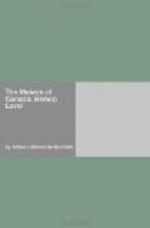The interior of the dwellings was not less simple, and we find still in our country districts a goodly number of these old French houses; they had only one single room, in which the whole family ate, lived and slept, and received the light through three windows. At the back of the room was the bed of the parents, supported by the wall, in another corner a couch, used as a seat during the day and as a bed for the children during the night, for the top was lifted off as one lifts the cover of a box. Built into the wall, generally at the right of the entrance, was the stone chimney, whose top projected a little above the roof; the stewpan, in which the food was cooked, was hung in the fireplace from a hook. Near the hearth a staircase, or rather a ladder, led to the loft, which was lighted by two windows cut in the sides, and which held the grain. Finally a table, a few chairs or benches completed these primitive furnishings, though we must not forget to mention the old gun hung above the bed to be within reach of the hand in case of a night surprise from the dreaded Iroquois.
In peaceful times, too, the musket had its service, for at this period every Canadian was born a disciple of St. Hubert. We must confess that this great saint did not refuse his protection in this country, where, with a single shot, a hunter killed, in 1663, a hundred and thirty wild pigeons. These birds were so tame that one might kill them with an oar on the bank of the river, and so numerous that the colonists, after having gathered and salted enough for their winter’s provision, abandoned the rest to the dogs and pigs. How many hunters of our day would have displayed their skill in these fortunate times! This abundance of pigeons at a period when our ancestors were not favoured in the matter of food as we are to-day, recalls at once to our memory the quail that Providence sent to the Jews in the desert; and it is a fact worthy of mention that as soon as our forefathers could dispense with this superabundance of game, the wild pigeons disappeared so totally and suddenly that the most experienced hunters cannot explain this sudden disappearance. There were found also about Ville-Marie many partridge and duck, and since the colonists could not go out after game in the woods, where they would have been exposed to the ambuscades of the Iroquois, the friendly




